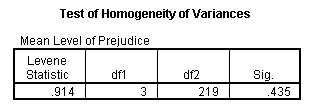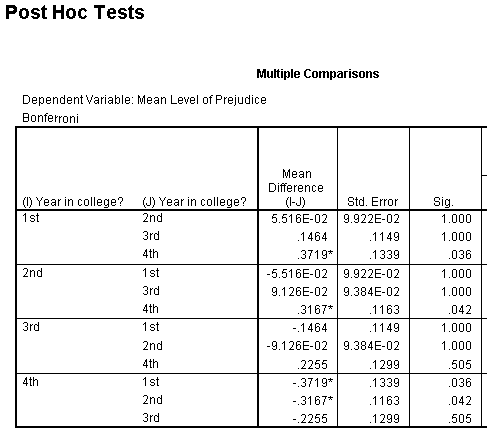![]()
What it does: The One-Way ANOVA compares the mean of one or more groups based on one independent variable (or factor).
Where to find it: Under the Analyze menu, choose Compare Means, then choose One-Way ANOVA. Move all dependent variables into the box labeled "Dependent List," and move the independent variable into the box labeled "Factor." Click on the button labeled "Options," and check off the boxes for Descriptives and Homogeneity of Variance. Click on the box marked "Post Hoc" and choose the appropriate post hoc comparison. Generally, for Psych 205 students, you can follow this rule: If there are equal numbers of cases in each group, choose Tukey. If there are not equal numbers of cases in each group, choose Bonferroni.
Assumptions:
-The dependent variable(s) is normally distributed. You can check for normal
distribution with a Q-Q plot.
-The two groups have approximately equal variance on the dependent variable.
You can check this by looking at the Levene's Test. See below.
Hypotheses:
Null: There are no significant differences between the groups' mean scores.
Alternate: There is a significant difference between the groups' mean scores.
SPSS Output
Following is a sample output of a One-Way ANOVA. We compared the mean level of prejudice of first-years, sophomores, juniors, and seniors. Mean level of prejudice is our dependent variable, and year in college is our independent variable.
First, we see the descriptive statistics for each of the 4 years in college.

It looks like first-years have the highest mean level of prejudice, and seniors have the lowest mean level of prejudice.
Next we see the results of the Levene's Test of Homogeneity of Variance.

This tells us if we have met our second assumption (the groups have approximately equal variance on the dependent variable). If the Levene's Test is significant (the value under "Sig." is less than .05), the two variances are significantly different. If it is not significant (Sig. is greater than .05), the two variances are not significantly different; that is, the two variances are approximately equal. If the Levene's test is not significant, we have met our second assumption. Here, we see that the significance is .435, which is greater than .05. We can assume that the variances are approximately equal. We have met our second assumption.
Finally, we see the results of our One-Way ANOVA:

Our F value is 3.110.
Our significance value is .027.
There is a significant difference between the two groups (the significance is less than .05).
Therefore, we can say that there is a significant difference between first-years, sophomores, juniors, and seniors on their level of prejudice.
We can look at the results of the Post-Hoc Comparisons to see exactly which pairs of groups are significantly different.

SPSS notes a significant difference with an asterisk (*). We can see that first-years and sophomores are significantly different than seniors.
Home
| Review Test | Decision
Tree | Procedure
List
Susan Archambault
Psychology Department, Wellesley College
Created By: Nina Schloesser '02
Created On: July 30, 2000
Last Modified: July 30, 2000